Hammer-Hooking: New Ideas
For Surfperch Fishing
- David Fong
Introduction:
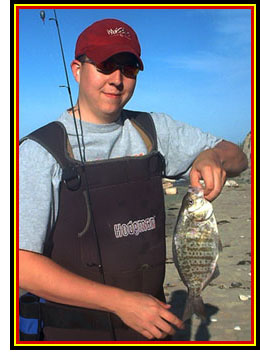 Surfperch fishing with soft plastic grubs like the 1¾ inch Big Hammer perch grub is some of the most accessible and fun fishing available along the Pacific Coast. Besides various species of surfperch, anglers can also catch croaker, corbina and halibut on these super-small baits year round. Here are some basics for surfperch fishing along with some updated ideas designed to make your outing more fun and productive.
Surfperch fishing with soft plastic grubs like the 1¾ inch Big Hammer perch grub is some of the most accessible and fun fishing available along the Pacific Coast. Besides various species of surfperch, anglers can also catch croaker, corbina and halibut on these super-small baits year round. Here are some basics for surfperch fishing along with some updated ideas designed to make your outing more fun and productive.
New Outfit?:
For gear, you probably already have an outfit you can use. Both baitcasting and spinning setups can be used but most prefer spinning as it's easier to cast the terminal rig described below. A fast to extra-fast graphite rod that's 6-6 to 8 feet paired with a spinning reel that holds 120 yards of 6 to 8-pound mono is perfect. Speaking of outfits, I wear chest waders in the winter and shorts and Tevas spring through fall here in Southern California.
It's Terminal:
The standard terminal rig to use is the Carolina Rig. Personally, I use 6-pound mono main line but switch to 6
or 8 pound fluorocarbon for the leader. The reason for this is that fluorocarbon is stiffer than mono so it better resists getting those pesky loop knots from the rig being tossed in the surf. Its low visibility in cleaner water doesn't hurt either. First, slide a 1/4,
3/8, or 1/2 oz. sliding egg sinker onto the main line. Next add a small glass or
plastic bead to keep the sinker from running over the swivel. Tie a #10 or #12
barrel swivel to the main line. For leaders, I use a 18 to 24 inch length for most surf conditions. I will shorten down to a 15 to 20 inch leader if the surf is a bit larger so the bait stays down in the strike zone better. Long leaders tend to ride too high when the surf is up. After tying the leader to the swivel, it's time for your hook. There are two choices below. We are having incredible success with the Hammer-Hooking method-try it and believe.

Carolina
Rig
Old School:
Traditional hooking typically utilizes a #4 baitholder-style hook threaded through the grub body. While this works and has been the standard for many years, there are some problems with this method. One of these is line twist-usually the leader alone or sometimes both the leader and the main line. Many times it's so severe that a barrel swivel isn't enough to counter the effect. Another problem is having the grub slide down from wear or short bites to the bend of the hook, thus preventing a good hook set. Lastly, smaller than desired perch are caught on occasion and it is sometimes difficult for the angler to get to the hook with this threading method.
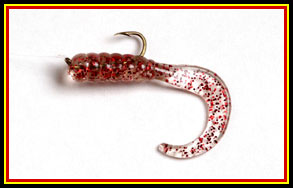
Traditional hooking using a #4 baitholder-style hook.
New School:
The new Hammer-Hooking or
open nose-hooking method uses a technique adapted from freshwater bass fishing
where drop-shot baits are commonly hooked the same way. For this method, use a
size 8, 6 or 4 Octopus-style hook like an an Owner Mosquito or Hayabusa Octopus. Simply run the hook point up through the body about 1-2 ribs back from the nose. Be sure that the hook is in line with the tail, not across it. This method of hooking allows greater action as the grub is able to swing on the hook bend. Line twist is virtually eliminated because there is no curve to the bait as with the traditional method mentioned previously-the curved hook is what causes the bait to spin.
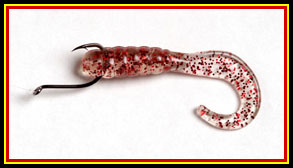
New Hammer-Hooking using a #4 Octopus-style hook.
Although short bites will still occur, we actually hook more of those fish as there is no hook to "bump into" and they just keep biting their way up the grub until they are hooked. For this reason, it is important to keep winding in the grub once you're bit. Many times you will actually reel the fish onto the hook. Deep hooking is virtually a thing of the past. As the grub slides up out of the way on a hook set (sometimes even up the line like a marlin lure), the hook tends to set just behind the upper lip or in the corner of the mouth. Perfect for easy releasing.
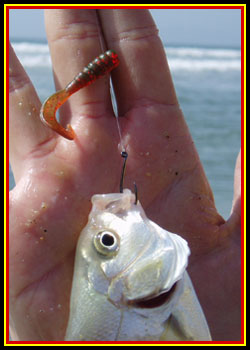
Even small
perch get hooked with the new method. Note how the grub slid up out of the way
for a perfect corner of the mouth hookset.
It's All Good:
There are many colors of Big Hammer perch grubs and all will get bit at one time or other. Have a range of darker colors for low light conditions or for when the water is cloudy. Switch to lighter colors for brighter conditions.
Motor Oil Red (#28) is a good basic choice. I switch to
Motor Oil Green (#92),
Motor Oil Christmas (#94) when it gets a bit brighter and then go to
Clear Red (#16) when it's high sun. Sometimes a specific color is required for when the fish are focused on particular forage. Blue Pearl (#240),
Great White (#102) or Glowbug (#69) can be good choices during the spring as they resemble both newly birthed perch fry
and sand crabs. An unusual color that has had very good results in a wide array
of conditions is
Sea Wolf (#60). Experiment and find some colors that you have confidence in.
Something Smells:
I use scents because they work, especially in tougher bites when fish aren't aggressive. I prefer Pro-Cure's
Sand Shrimp Super Gel.
Location, Location, Location:
Almost all sand beaches hold surfperch, croaker, corbina and halibut somewhere along them. Be sure to move around and cover the whole beach. Many times 90% of the fish are in 10% of the water. Sometimes they are only 15 feet off the dry sand. Look for deeper troughs or "holes"-darker water areas with less wave activity. Fish tend to congregate and feed in these areas. Sand clouds in the water mean stirred-up food-and feeding fish. Points where two receding waves wash into each other and back out are good. Cast into these areas and begin a slow to medium steady retrieve letting the sinker ride along the bottom. Try casting on an angle across the areas to cover more water. If you are bit-typically a tap or series of taps-keep reeling and then swing lightly to set the hook so you don't snap your line. Fish on!

Fish hold
in the deeper, darker water and charge up to feed in the rip clouds marked by
the red arrows. Notice how close to the beach this is occurring.
Beyond Grubs, Carolina-rigs
& Monofilament:
- Pete Wolf
This article was written with
the intention of introducing nose-hooking to the world of fishing grubs on
Carolina-rigs for surfperch. Which it did... for me personally... a change that
increased my surf perch fishing success dramatically. But as with most things,
it didn't stop there. I've never enjoyed fishing the Carolina-rig. Too many
knots, too much terminal tackle, it gets tangled, and I do not like rigs where the sinker is "in
front" of the bait. I prefer rigs like the drop-shot where the angler has direct
contact with the "hook" so to speak... no sinker in between to get in the way.
So, years later when
the 2 inch swimbait was introduced we started drop-shotting it for
freshwater bass and thought "Why not try this for surf perch?". And once again,
dramatically changed the way we fish for surf perch... or the occasional
halibut.

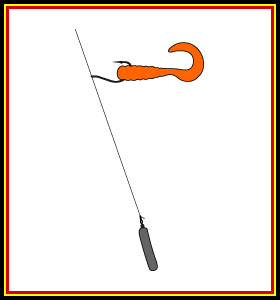
The gear has not changed but
I have switched to braided line and fluorocarbon leaders for all of the fishing
I do. For the surf I prefer 20 lb. braided line and a 12 or 15 lb. fluorocarbon
leader.
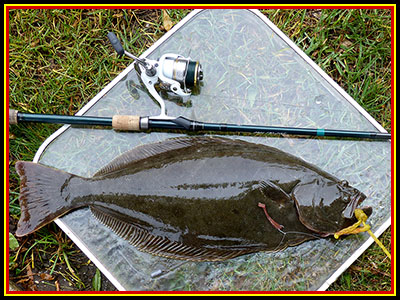
When the big perch move in or
it is later in the year and I am specifically targeting halibut I will switch to
the 3 inch Big Hammer swimbait usually
rigged on a 1/4 oz. jig head. In most cases I
will start the day with the drop-shot and then switch over to the swimbait if it is a good
bite and the average fish are on the larger side. Or sometimes I will rig a combination of
both using the 3 inch swimbait as the "sinker" and drop-shotting a 2 inch
swimbait (or grub) above it if I can't decide what to do or if I think the
presence of multiple baits will help draw strikes.
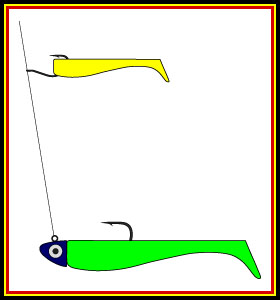

Just tie it straight to your
main line and cast and retrieve. There are several retrieve styles. I
will try them each in the order below... and then randomly until I find
something that's working.
1 - Simply cast and start
reeling. Medium retrieve speed. If there are no takers try slowing down, then
try speeding up.
2 - Shake the rod tip (slight
constant small movements - the rod tip shouldn't move more than a few inches)...
known affectionately as the "Rich Twitch".
3 - The third
retrieve is much like the first except for a quick pause every 2 to 4 cranks of
the handle.
4 - The fourth is to let the swimbait sink to the bottom after the
cast, once it hits the bottom give the reel 1 to 3 quick cranks, pause and let
it hit the bottom again. Continue this pattern all the way in.
5 - The fifth retrieve I've
used on occasion with success is one I learned fishing for speckled trout in
North Carolina. Cast, a few cranks of the reel to take up the slack, then a big,
quick, forceful snap of the rod tip back and then forward (slack line - watch
for strikes!) until the bait sinks (if it doesn't get bit) and pulls out the
slack... repeat. The fish always seem to hit on the drop... halibut too.

Click
here to
read "Hammering Inshore Halibut" for more information about fishing
the 3 inch Big Hammer swimbait in the surf.

Big Hammer™, Hammer Swimbaits™, Square Tail™, Rectangular Tail™, Square Tail
Design™, Rectangular Tail Design™ and the rectangular shaped swimbait tail
design are all trademarks owned by Sunrize Tackle, Inc. (parent company of Big
Hammer Lures). Use of these terms without written permission by Sunrize Tackle,
Inc. is prohibited by law.
The photos,
images, text and content of the Big Hammer™ website are copyrighted. These items
and information are
provided for your convenience and are only intended to be used in the positive
promotion
and sale of Big Hammer™ products. All other use is prohibited by law.
Big Hammer products are
not intended to be used by children under 13 unless accompanied by an adult.
© Copyright Sunrize Tackle, Inc. - All Rights Reserved.
 Surfperch fishing with soft plastic grubs like the 1¾ inch Big Hammer perch grub is some of the most accessible and fun fishing available along the Pacific Coast. Besides various species of surfperch, anglers can also catch croaker, corbina and halibut on these super-small baits year round. Here are some basics for surfperch fishing along with some updated ideas designed to make your outing more fun and productive.
Surfperch fishing with soft plastic grubs like the 1¾ inch Big Hammer perch grub is some of the most accessible and fun fishing available along the Pacific Coast. Besides various species of surfperch, anglers can also catch croaker, corbina and halibut on these super-small baits year round. Here are some basics for surfperch fishing along with some updated ideas designed to make your outing more fun and productive.









